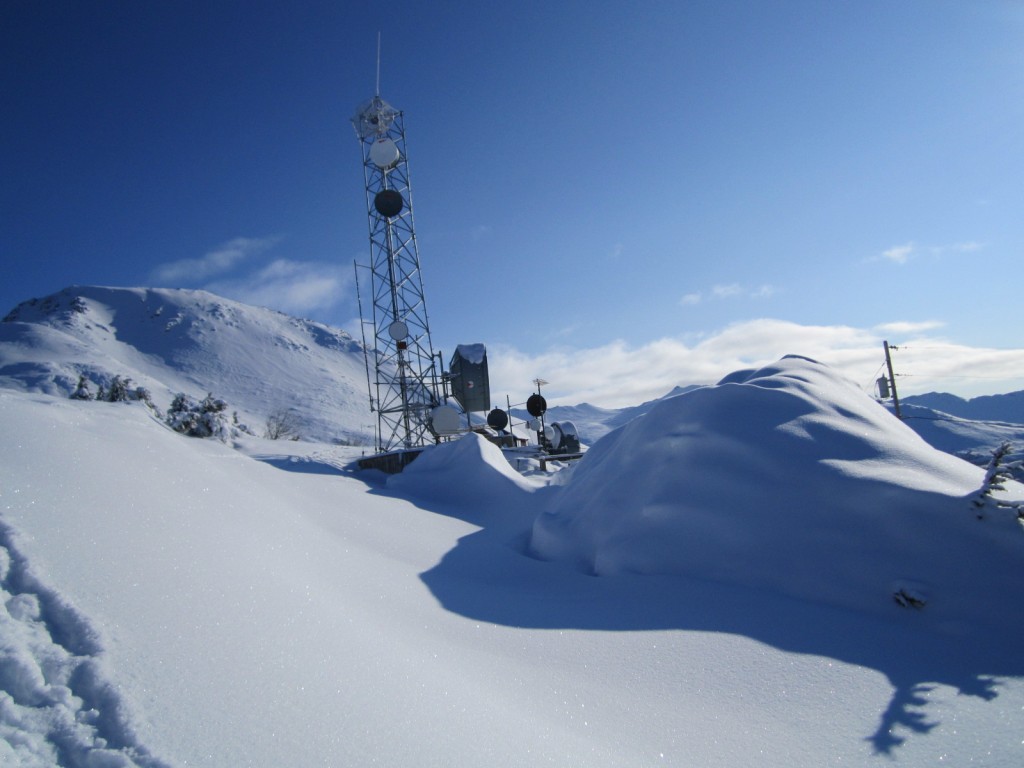
When you think of KSKA-Anchorage, you probably think of the voices you hear every day over the air — Bede Trantina, Connie Huff, Lori Townsend. But behind the scenes, KSKA has a team of engineers whose job it is to make sure those voices make it to your radios. And it’s not an easy gig. Let’s see how it works — how KSKA’s FM radio signal gets from us to you. Take a listen.
A lot of us start our mornings with KSKA… in the house, in the car. Have you ever wondered how that signal gets to you? Welcome to the wonderful world of FM radio. Let’s take a little trip behind the scenes.
The signal originates from KSKA’s on-air room. At 5:00 a.m. — you will actually find a human here most days.
Bede staffs the helm of KSKA’s sound board at 5:20 on an early October morning.
Ahhh, NPR Morning Edition. It’s a popular program in this neck of the woods. Bede sits in front of an audio board, and there’s a red “on” light under one of the faders with the volume turned up.

The audio board Bede is piloting connects to Alaska Public Media’s master control room.
You’ve heard the saying, “Houston, we have a problem”…? This place is KSKA’s ‘Houston.’
Engineer Ron Zastrow and I head into master control.
“Why’s it so loud in this room?”
“There’s a lot of fans, lots of computers, so there’s a lot of noise being generated… and a lot of air moving around,” Zastrow says. He’s one of the station’s seven engineers. The control room is his kingdom.
As a visitor to the control-room-kingdom, the place looks like a mess of wires and machinery. Zastrow insists it’s organized chaos.
In here, the audio originating from KSKA’s on-air studio is getting ready to head out the door.
Zastrow takes us on a short tour. “These two racks of equipment are primarily audio processing.”
“So not FM-radio just yet?”
“Nope. Long way from FM radio… just ones and zeros.”
Audio is getting rendered into a high-frequency format that can travel easily over long distances. In radio-speak, the term is multiplexing, or muxing for short.
The muxed audio heads out over a physical wire to KSKA’s tower house — which is right next door to the station’s studios on the Alaska Pacific University campus. It’s a medium-sized tower — about a hundred and forty feet tall — but it makes this place look like a radio station.

Audio from KSKA’s tower is sent to a radio tower at Glen Alps. The Glen Alps site is a hugely important step in the journey of KSKA’s FM signal.
We head over on a crispy fall October afternoon. Ron needs to service the tower’s generator, so we stop by a gas station on the way out of town to fill a couple of jerry cans with diesel.
“The Glen Alps tower is a relay point between Alaska Public Media studios and Goose Bay and the Kenai Peninsula,” Zastrow explains.
Ideally for Ron, KSKA’s signal would go straight from KSKA’s tower to Goose Bay. But the Elmendorf morraine is in the way.
“The frequencies that we work at are all line of sight,” he adds — meaning, you actually have to see the towers you’re trying to transmit to for this thing to work. From Glen Alps we can see KSKA’s tower and the Goose Bay tower. Check and check.
We head over to the generator and Ron sets up a funnel over the fuel tank. In goes the diesel. It sounds like it’s going pretty far down… Zastrow says he’ll likely have to come back with a few more cans.
At about 90 feet tall, the Glen Alps tower is a small one.
“It is the little engine that could, it does do a lot,” Zastrow says. His affection for the little-tower-that-could is clear.
The takes advantage of Glen Alps’ natural altitude to be effective. That also means it weathers some nasty winds and temperatures up here. Power outages are not that uncommon.
“If this site goes down… we lose all the broadcast in Anchorage and on the Kenai Peninsula — so it’s very important the generator starts when it needs to,” Zastrow says.
“How often does the site go down?”
“Not very often… maybe once a year. It went down a couple of weeks ago for a power outage,” Zastrow says. But the site’s generator automatically switched on, as it’s supposed to. “Nobody even knew [about the power outage].”
From Glen Alps, KSKA’s signal heads over to the tower at Goose Bay. The Goose Bay tower is like the broadcast equivalent of the Glenn Highway. It’s the tallest tower in the state. Eight-hundred and four feet of broadcast muscle.
Multiple TV and radio stations in Anchorage use the Goose Bay tower to broadcast their content. It’s just over the Knik Arm side of Cook Inlet… seventy miles by car, about eight as the bird flies.
Goose Bay is the last stop for KSKA’s radio signal. It gets converted from it’s high-frequency, transport-only format into FM radio waves.
The audio you hear has been sent from the KSKA studios to the KSKA tower, the KSKA tower to Glen Alps, and lastly, Glen Alps to Goose Bay before making it to you.
So when you turn your radio’s dial to ninety-one-point-one FM in Anchorage, KSKA is what you hear. In your home, in your car, wherever you listen.





